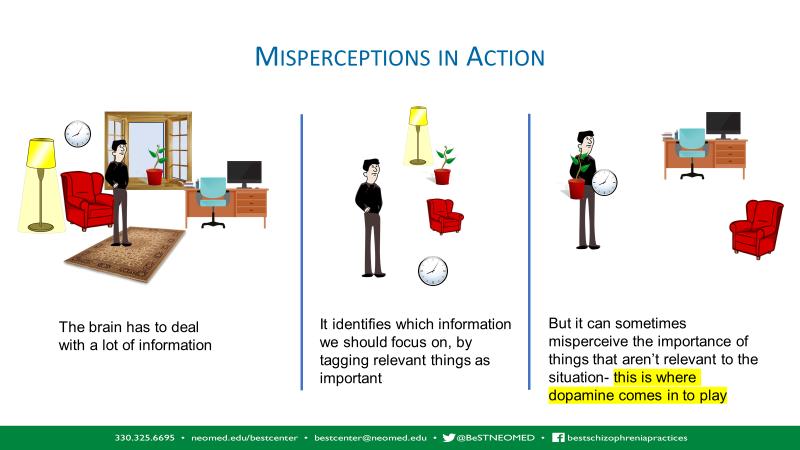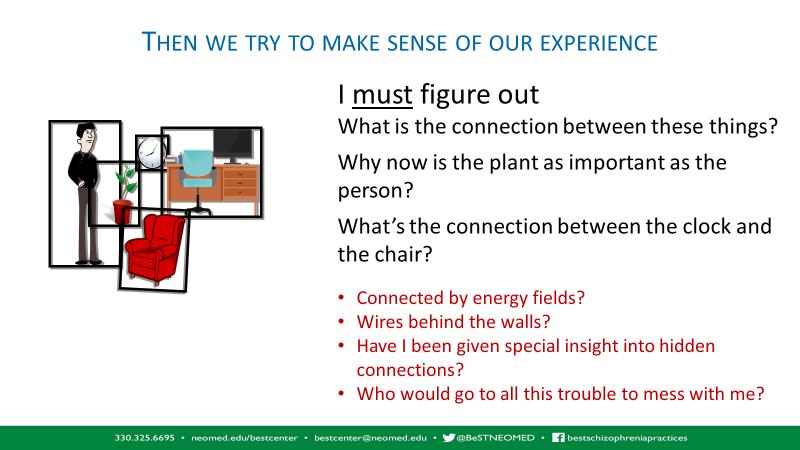
12 minute read
Part 1: Psychosis and an Approach to Care
Section 1
Introduction to Recovery Enhancement Practices for Psychosis (REP) Part 1: Psychosis and an Approach to Care
Advertisement
Objectives:
1. 2. To describe psychosis and schizophrenia To provide an overview for an approach to care
Introduction: What is Psychosis?
Psychosis refers to a state of mind in which reality testing is impaired. The root meaning of the word “psychosis” is psyche (soul or mind) and “osis” (unusual or abnormal state). So, we might say psychosis reflects an unusual or altered state of mind. For a variety of reasons, our brains are prone to misperceive information and when this happens to the extent that it causes serious distress and/or impairment, we refer to the experience as a psychotic symptom. For example, hallucinations involve misperceived sensations (e.g., hearing a voice when no one is around). A delusion refers to a strongly and rigidly held belief based on information that is objectively inaccurate/illogical, not consensual (see below) and leads to distress and impairments in living.
To help understand what this means concretely, it may be helpful to consider what we mean by “reality.” Robert Francis, an author and person with lived experience of psychosis, describes the distinction between consensus and private reality as a way to think about psychosis. Consensus or “shared reality” refers to experiences that you and I share in common. For example, we see two people walking in our neighborhood and we can agree we see two individuals. Private reality refers to experiences that relate to one’s private interpretation of a situation. For example, I may consider the appearance of two individuals in the neighborhood as worrisome while you may not be concerned about it at all. With some explanation of past encounters with these individuals (maybe they were rude to me in the past or disrupted the yard, etc.), you can understand my perspective even though you do not hold the same belief or concern. When private experiences become more unusual, illogical, or lacking in objective evidence (for example, I see two people appearing in neighborhood that are not seen by others and I believe represent aliens who intend to hurt me) AND causes impairment and distress, we move into the space that we would call a psychotic symptom. The experience is very real to me (private reality), but this experience does not fit with common experience or knowledge (consensus reality). Likewise, if I hear voices telling me that they wish me harm (that no one else hears), and I feel distress, and run and hide in my house for days, this would also meet the criteria for a psychotic symptom (specifically a hallucination).
A couple of key points to remember about psychosis:
1. While we may not immediately understand a person’s experience, we should not discount it. It is often very personal and powerful for the person who experiences it.
2. It is not just having an unusual experience that qualifies it as psychosis. A person must also experience distress and interference with daily living (remember we all experience unusual things at times, and we all have idiosyncratic beliefs).
3. The person’s ability to consider his or her psychotic symptom from another perspective is impaired. In other words, it is less about willful opposition and more about impaired cognitive processing ability.
The term “schizophrenia” is diagnostic label for individuals who exhibit symptoms of psychosis and who experience a sharp decline in their ability to function. See table 1 (See table at end of section) for descriptions of behaviors commonly observed in individuals with this diagnosis. A brief experience of any one of these symptoms does NOT constitute schizophrenia. The experiences must occur for a substantial period of time and significantly disrupt a person’s life. Of note, while psychosis is a more generalized term for a type of human experience, schizophrenia is a diagnosis based on set criteria.
Schizophrenia as a diagnosis is often feared and misrepresented. Despite decades of research, this diagnosis is still poorly understood and defies easy categorization. It is important to realize that schizophrenia does not present in just one way. This is why we often refer to schizophrenia “spectrum” disorders. There are multiple “causes,” different underlying mechanisms, and different presentations. Also, an individual may show symptoms of psychosis and not be diagnosed with a schizophrenia spectrum disorder (e.g., some mood disorders and personality disorders also show psychotic symptoms).
This guide is written for the frontline providers who work with individuals who experience psychosis and want to know how to make a difference. The foundation for this work was developed primarily from work with individuals who were diagnosed in the “schizophrenia spectrum.” We believe that many features of this approach are broadly applicable to psychotic symptoms occurring outside of schizophrenia spectrum diagnoses, but as a matter of good practice, we encourage you to consult with your supervisor and trainer for case-specific adaptations.
It is our hope that this guide will provide a simple and clear explanation of common psychotic experiences. This guide will share helpful tips and strategies that have been developed over many years by clinicians, researchers, and persons with lived experience of psychosis.
Recovery Enhancement Practices for Psychosis (REP) are based on a deep respect for the dignity of individuals combined with a strong belief that people have the capacity to better their lives. These practices are informed by elements of Cognitive Behavioral Therapy for psychosis and guided by advances in the recovery movement. While schizophrenia is a challenging illness, individuals who experience this condition also have tremendous strengths that will become increasingly apparent (this may already be apparent to you) after doing this work.
It is important to be gentle with yourself as you learn to work with psychosis. This work takes time, it is challenging, and it is also wonderfully enriching. Once you learn to welcome the uncertainty and vulnerability required of the work, you will discover new ways to encounter individuals who experience psychosis that will enhance your professional work (see McCraw and Brabban, 2002).
Understanding the causes of schizophrenia
Schizophrenia as a term does not help us to understand the physiology of schizophrenia or psychotic symptoms. It translates to “split mind” and is a term coined more than 100 years ago. People diagnosed with schizophrenia can present in vastly different ways. For our purposes, it is helpful to briefly consider some factors that contribute to psychotic symptoms. Dopamine is a neurotransmitter that has been identified as having a primary role in psychosis. We discussed earlier that psychosis often involves misperception and an altered state of mind. Dopamine plays a role in helping us to determine what to pay attention to in order to respond appropriately. If there is too much dopamine or dopamine is not effectively regulated, the brain may misinterpret situations as dangerous or “very important” even though others in the same situation see them as relatively neutral. Dopamine, along with other underlying mechanisms, is also thought to influence the experience of hearing voices.
Figure 1. How dopamine, perception and thinking combine to make unusual experiences.

Since the 1950s treatment for schizophrenia has included some type of antipsychotic medication. The effectiveness of this type of treatment has brought about important improvements in the care and management of individuals suffering from these disorders. Notably, most of the early medicines affected the dopamine system. Psychosis is not always caused by dopamine irregularities. Other neurotransmitters, such as glutamate, may be primarily involved. In addition, psychosis can be caused by a variety of mechanisms (e.g. trauma, medical illness, inflammation, or other neurological processes). However, if a person’s experience of psychosis comes from another primary source (as described above), then altering the dopamine system would not help much. This may be one reason why some people seem to get better quickly with medication while others do not seem to improve much on similar medicines.
Even with a better understanding of medication options, in many cases, medication alone still does not provide adequate relief (Gould, Mueser, Bolton, Mays, & Goff, 2001; Morrison, Hutton, Shiers, & Turkington, 2012). Other factors, like the role of trauma, need to be considered when working with someone who experiences psychosis.
Besides medicine, what else might help?
Cognitive Behavioral Therapy has been adapted for clients with persistent psychotic symptoms (CBT-p) and has shown benefits in treating individuals with schizophrenia spectrum disorders (Wykes, Steel, Everitt, & Tarrier, 2008). For example, this treatment has improved outcomes related to the positive and negative symptoms of schizophrenia as well as overall well-being.
Unfortunately, very few individuals with schizophrenia receive CBT-p in the United States. This form of therapy requires advanced training that is not widely available. In an effort to address the lack of access to evidence-based practices, one area that has received very recent attention is the delivery of so-called “low intensity” CBT interventions (Bennet-Levy, et al., 2010). There are several characteristics associated with the designation of “low intensity”: Short amount of time (not a full therapeutic hour)
Provided by frontline staff, many of whom are not licensed therapists
Content and activities are “lower intensity;” (e.g., simple coping strategies; self-help materials and self-directed learning)
Mental health nurses (not traditionally licensed therapists) delivered brief CBT (six sessions) to individuals with a schizophrenia spectrum illness in the United Kingdom (Turkington, Kingdon, and Turner, 2002) who reported improvements in symptoms and positive satisfaction ratings. In more recent years, Pinninti, et al. (2010) also described a small pilot study in which they successfully trained members of an Assertive Community Treatment (ACT) team (case managers and other non-experts) in CBT. Waller et al. (2013) reported positive results in a small exploratory study in which frontline workers applied lower intensity CBT methods such as behavioral activation and graded exposure to individuals with schizophrenia spectrum illnesses. In another exploratory study, Turkington and colleagues (2014) trained case managers to provide low intensity cognitive behavioral techniques and found that clients responded with improvements in areas such as hallucinations, depression, and social functioning. Although variably defined, low-intensity CBT-p has demonstrated benefits for positive symptoms (Hazell, Hayward, Cavanagh, & Strauss, 2016; Naeem, Farooq, & Kingdon, 2014).
The above results suggest that techniques derived from CBT-p can be applied in non-traditional ways with benefits to the client. Therefore, if more providers could deliver a range of CBT-p related services within a community mental health agency (see table below), more individuals who experience psychosis could receive care (see Kopelovich, et al., 2019).
•Peer recovery support •Family/caregiver •Community health worker •Self-guided CBT-p Informed Care
Low Intensity CBT-p
•MA-level providers •Psychiatrists
Group CBt-p
•MA-level providers & allied professionals •ACT-p; CBSST; Group CBT-p
High Intensity CBT-P
•MA and Doctoral-level clinical specialists
CBT-informed interventions are characterized by more straightforward strategies that require less time, and that can be delivered in the context of a mental health worker’s other duties. Three skills are foundational for effective work with psychosis (this approach is loosely modelled after the United Kingdom’s Psychological Well-Being Providers):
1.
2.
3. Skillful engagement and information gathering - developing a supportive working relationship and learning about the person. Skillful information giving - providing information in a way that is instructive, normalizing, and hopeful. Shared decision-making - working together in a way that empowers the person with choices and supports the person’s ownership of successes.
This guide will focus on a CBT-p informed care approach we call Recovery Enhancement Practices for Psychosis (REP). This term is used to not confuse or mislead the provider or receiver of services that CBT-p is being provided. This approach can be provided by non-licensed staff who have received intensive training and ongoing consultation and undergone a review of work samples. REP techniques are considered the foundational skills for working with anyone who experiences psychosis, so it fits a wide range of providers. To ensure quality care, this model also requires that individuals employing REP strategies are supervised by individuals who are independently licensed and who are qualified at the lowintensity CBT-p level of the continuum.
Training an entire team in this approach is the best way to apply the full spectrum of CBT-p services. Counselors, therapists, and others who are licensed to provide therapy would be responsible for high- and low- intensity psychotherapy interventions. Other members of the team (case manager, supported employment specialist, nurse, recovery specialist, etc.) provide REP within the context of their job duties and that is appropriate to their scope of practice. In this way, the team can be unified by a common language and model for intervention. Team members can also support one another in developing and coordinating interventions based on the CBT- p model.
The core goal of the stepped-care approach to CBT-p is to engage individuals at the most appropriate level to assist them in a process of defining and improving their personal quality of life.
Treatment in a larger context
Recovery Enhancement Practices are not a standalone approach; instead, they can interact with a number of other interventions. A person with schizophrenia would do well with access to a variety of services (See Section 1 Highlights). Notice that REP fits well with the other services in this model. Please note that the person (i.e., client) is at the center of the model to indicate the critical importance of his or her choices. Outcomes are improved with an integrated, specialized team-based approach.
Symptom Explanation
Symptom Name Hallucinations Definition
A sensory experience (hearing, seeing, smelling, feeling touch, taste) experienced by an individual that is not perceived by others or where there is no clear evidence to support the experience
How this may look in the field
Person talking to themselves Person looking around as if responding to something others cannot hear or see Complaints of feeling probed by others Person reports a voice is talking to them
Delusions
Thought disorganization
Negative Symptoms
Strongly held beliefs that are not supported by evidence, logic, or not within the range of consensus reality Extreme difficulty or inability to think in a linear and organized way. There may be intrusions of different thoughts
A cluster of symptoms that represents certain essential functions that are diminished or “taken away” from the individual Limited speech Flat affect Avolition: Not able to get started to do things Person states that they are a king or prophet Person states that the devil is probing their mind Person speaks in rhymes, or nonsensical Person states that there is a chip in their language. brain May repeat phrases that don’t make sense Person stays to self, puts up protections in context around their house May miss or be late for appointments, not Person is hyper-vigilant, disguises complete paperwork effectively, may not him/herself or avoids others recall content of meetings or appear distracted Person may stay in room all day Appearance may be unclean, room disorganized, not engaging in activity Emotions may appear to be absent; appears bored or as having no energy







